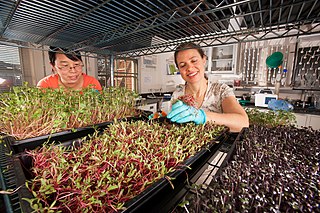
Broccoli sprouts are three- to four-day-old broccoli plants that look like alfalfa sprouts, but taste like radishes.

Broccoli sprouts are three- to four-day-old broccoli plants that look like alfalfa sprouts, but taste like radishes.
While health-conscious people in the 1970s embraced raw sprouts as a dietary staple, it was not until the 1990s that broccoli sprouts entered the mainstream. A 1997 discovery about high levels of glucoraphanin in broccoli sprouts was written about in a New York Times article, [1] and created a global shortage of broccoli seed that could not meet the sudden high demand.
Broccoli sprouts are rich in sulforaphane. Although there has been some basic research on how sulforaphane might exert beneficial effects in vivo , there is no high-quality evidence for its efficacy against human diseases. [2] [3]
Broccoli sprouts also contain a particular glucosinolate compound, glucoraphanin, which is found in vacuoles within the cytoplasm of the plant cell.[ citation needed ]
Broccoli sprouts are available in health foods stores and some grocery stores in most of the developed world and other countries. Broccoli seeds are available for home growing. One can sprout broccoli seeds using a jar [4] or a commercial sprouting kit. Broccoli sprout powders and capsules are also available. However, many of these products are produced from myrosinase-inactive sprout or seed extracts.[ citation needed ] It is difficult, if not impossible, for the consumer to identify which products contain both the essential precursor glucoraphanin as well as the active myrosinase enzyme. With a myrosinase-inactive product, an individual may not convert any of the glucoraphanin to sulforaphane. Because so little is known about the role of human gut microflora at this stage, reliance on the gut microflora with its wide variability could pose a significant limitation on the achievement of a biochemical response.
The U.S. Food and Drug Administration (FDA) issued suggested protocols [5] recommending commercially grown sprout seeds be soaked and sterilized with 20,000 PPM calcium hypochlorite prior to sprouting.
A study published in Nutrition Journal quantifies the effectiveness of sprout safety programs. [6]

Aspartame is an artificial non-saccharide sweetener 200 times sweeter than sucrose and is commonly used as a sugar substitute in foods and beverages. It is a methyl ester of the aspartic acid/phenylalanine dipeptide with brand names NutraSweet, Equal, and Canderel. Aspartame was approved by the US Food and Drug Administration (FDA) in 1974, and then again in 1981, after approval was revoked in 1980.

Sucralose is an artificial sweetener and sugar substitute. As the majority of ingested sucralose is not metabolized by the body, it adds no calories. In the European Union, it is also known under the E number E955. It is produced by chlorination of sucrose, selectively replacing three of the hydroxy groups—in the C1 and C6 positions of the fructose portion and the C4 position of the glucose portion—to give a 1,6-dichloro-1,6-dideoxyfructose–4-chloro-4-deoxygalactose disaccharide. Sucralose is about 600 times sweeter than sucrose, three times as sweet as both aspartame and acesulfame potassium, and twice as sweet as sodium saccharin.

The soybean, soy bean, or soya bean is a species of legume native to East Asia, widely grown for its edible bean, which has numerous uses.

Dietary fiber or roughage is the portion of plant-derived food that cannot be completely broken down by human digestive enzymes. Dietary fibers are diverse in chemical composition, and can be grouped generally by their solubility, viscosity, and fermentability, which affect how fibers are processed in the body. Dietary fiber has two main components: soluble fiber and insoluble fiber, which are components of plant-based foods, such as legumes, whole grains and cereals, vegetables, fruits, and nuts or seeds. A diet high in regular fiber consumption is generally associated with supporting health and lowering the risk of several diseases. Dietary fiber consists of non-starch polysaccharides and other plant components such as cellulose, resistant starch, resistant dextrins, inulin, lignins, chitins, pectins, beta-glucans, and oligosaccharides.

Genetically modified foods, also known as genetically engineered foods, or bioengineered foods are foods produced from organisms that have had changes introduced into their DNA using various methods of genetic engineering. Genetic engineering techniques allow for the introduction of new traits as well as greater control over traits when compared to previous methods, such as selective breeding and mutation breeding.

Sprouting is the natural process by which seeds or spores germinate and put out shoots, and already established plants produce new leaves or buds, or other structures experience further growth.

In organic chemistry, isothiocyanate is the functional group −N=C=S, formed by substituting the oxygen in the isocyanate group with a sulfur. Many natural isothiocyanates from plants are produced by enzymatic conversion of metabolites called glucosinolates. These natural isothiocyanates, such as allyl isothiocyanate, are also known as mustard oils. An artificial isothiocyanate, phenyl isothiocyanate, is used for amino acid sequencing in the Edman degradation.

The Brussels sprout is a member of the Gemmifera cultivar group of cabbages, grown for its edible buds.

Cannabidiol (CBD) is a phytocannabinoid discovered in 1940. It is one of 113 identified cannabinoids in cannabis plants, along with tetrahydrocannabinol (THC), and accounts for up to 40% of the plant's extract. As of 2019, clinical research on CBD included studies related to anxiety, cognition, movement disorders, and pain, but there is insufficient high-quality evidence that cannabidiol is effective for these conditions. Nevertheless, CBD is a herbal dietary supplement promoted with unproven claims of particular therapeutic effects.

Brassica oleracea is a plant species from family Brassicaceae that includes many common cultivars used as vegetables, such as cabbage, broccoli, cauliflower, kale, Brussels sprouts, collard greens, Savoy cabbage, kohlrabi, and gai lan.
The lignans are a large group of low molecular weight polyphenols found in plants, particularly seeds, whole grains, and vegetables. The name derives from the Latin word for "wood". Lignans are precursors to phytoestrogens. They may play a role as antifeedants in the defense of seeds and plants against herbivores.

Sulforaphane is a compound within the isothiocyanate group of organosulfur compounds. It is produced when the enzyme myrosinase transforms glucoraphanin, a glucosinolate, into sulforaphane upon damage to the plant, which allows the two compounds to mix and react.

Glucoraphanin is a glucosinolate found in broccoli, mustard and other cruciferous vegetables.

Glucosinolates are natural components of many pungent plants such as mustard, cabbage, and horseradish. The pungency of those plants is due to mustard oils produced from glucosinolates when the plant material is chewed, cut, or otherwise damaged. These natural chemicals most likely contribute to plant defence against pests and diseases, and impart a characteristic bitter flavor property to cruciferous vegetables.

Cruciferous vegetables are vegetables of the family Brassicaceae with many genera, species, and cultivars being raised for food production such as cauliflower, cabbage, kale, garden cress, bok choy, broccoli, Brussels sprouts, mustard plant and similar green leaf vegetables. The family takes its alternative name from the shape of their flowers, whose four petals resemble a cross.

Microgreens are vegetable greens harvested just after the cotyledon leaves have developed with one set of true leaves. They are used as a visual, flavor and texture enhancement. Microgreens are used to add sweetness and spiciness to foods. Microgreens are smaller than "baby greens" because they are harvested soon after sprouting, rather than after the plant has matured to produce multiple leaves.

Myrosinase is a family of enzymes involved in plant defense against herbivores, specifically the mustard oil bomb. The three-dimensional structure has been elucidated and is available in the PDB.

Urolithin A is a metabolite compound resulting from the transformation of ellagitannins by the gut bacteria. It belongs to the class of organic compounds known as benzo-coumarins or dibenzo-α-pyrones. Its precursors – ellagic acids and ellagitannins – are ubiquitous in nature, including edible plants, such as pomegranates, strawberries, raspberries, walnuts, and others.

Paul Talalay was the John Jacob Abel Distinguished Service Professor of Pharmacology and director of the Laboratory for Molecular Sciences at the Johns Hopkins School of Medicine in Baltimore. He was the founder of the Brassica Chemoprotection Laboratory for the study of edible plants that induce protective enzyme activity in the body and may help prevent the development of cancer.

Benzyl isothiocyanate (BITC) is an isothiocyanate found in plants of the mustard family.